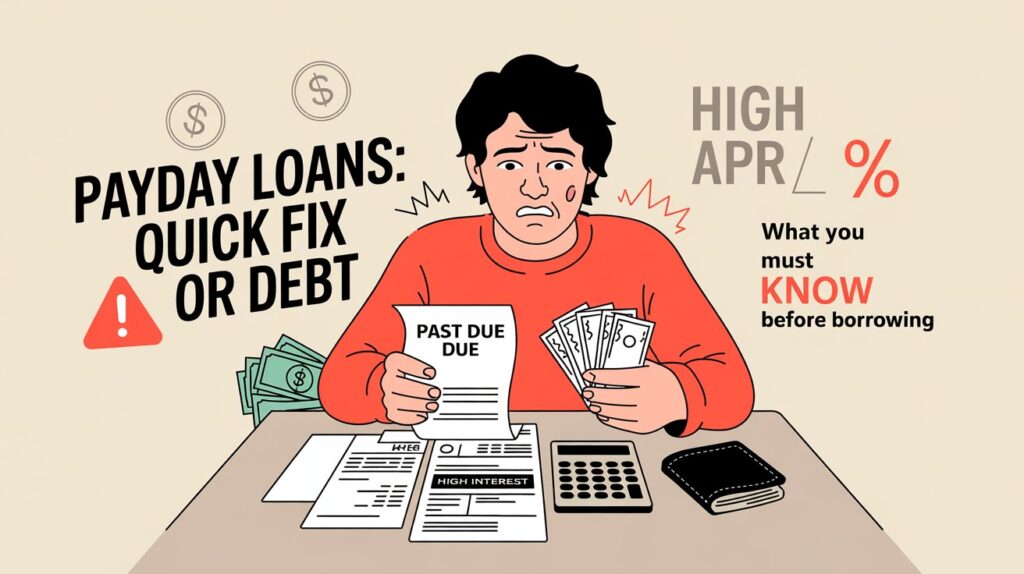Let’s be honest—life happens. A car breaks down, a medical bill shows up, or the rent’s due before your next paycheck. In those moments, you might feel cornered and desperate for fast cash. That’s when many people consider payday loans.
These loans promise a lifeline, offering small amounts of money with no credit checks and instant approvals. Sounds like a blessing, right? Well, not quite. Let’s dig deeper into what payday loans really are, how they work, and what you need to know before considering one.
What Exactly Is a Payday Loan?
A payday loan is a short-term, high-interest loan—typically $500 or less—meant to be repaid by your next paycheck. They’re popular because they’re fast, easy to qualify for, and often require nothing more than:
- A valid ID
- Proof of income
- An active checking account
You’ll usually get the money within hours. The catch? The annual percentage rate (APR) can soar over 300%. That means if you don’t repay on time, things can spiral out of control—fast.
How Payday Loans Work (And Why That’s a Problem)
Application Process
Applying for a payday loan is quick. Whether online or in a storefront, all you do is fill out a form with your income details. No credit score needed. If approved, the lender might give you the cash on the spot or deposit it in your bank account.
Let’s say you borrow $300. You might agree to pay $345 in two weeks—$300 in principal and a $45 fee.
Sounds manageable, right? But if you can’t repay it by then, things get messy.
The Repayment Catch
The repayment structure is where payday loans get tricky. You typically owe everything—principal plus fees—at once, on your next payday.
Can’t pay? Many lenders offer rollovers, letting you extend the loan by paying another fee. So your $300 loan with a $45 fee becomes $390 after one rollover. The principal doesn’t shrink—you’re just stacking fees.
This is how people end up stuck. It’s not unusual for borrowers to end up paying back double or even triple what they originally borrowed.
What Do Payday Loans Really Cost?
Here’s a breakdown using real numbers:
- $15 fee per $100 borrowed is a common rate
- That’s $45 on a $300 loan
- For a two-week loan, that equals an APR of 391%
- Roll it over once, and your total cost becomes $90 in fees
And that’s without counting late fees, bank overdraft charges, or NSF (non-sufficient funds) penalties if your bank balance can’t cover the withdrawal.
Why Do Payday Loans Target Certain People
These loans don’t usually go to folks with good credit or healthy savings. Payday lenders often serve people:
- With low income
- From minority communities
- Who are single parents, women, or young workers
- Lacking access to traditional credit cards or personal loans
If that’s you, know this: You’re not alone, and there are safer alternatives.
What the Law Says (and What’s Missing)
Federal and State Oversight
The rules around payday loans vary a lot depending on where you live:
- Colorado: Caps fees at $30 per $100, with a six-month minimum term
- California: Allows fees up to $45 for a $300 loan
- Ohio: Limits loans to $500, with at least 91 days to repay
The Consumer Financial Protection Bureau (CFPB) has tried to step in—requiring lenders to check your ability to repay—but regulations shift with each administration. In 2025, new rules are in place again, pushing for more borrower protections.
Some States Said “Nope”
As of now, 16 U.S. states have effectively banned payday lending, either by capping interest rates or imposing strict conditions. If you’re in one of those states, consider yourself lucky—it likely saved you from a costly cycle.
Pros and Cons of Payday Loans (Let’s Be Real)
✅ When They Help:
- Speed: You can get money in minutes.
- Simplicity: No credit score or paperwork hurdles.
- Accessibility: Available to people with no other options.
❌ When They Hurt:
- Extreme Interest Rates: You’ll pay way more than you borrowed.
- Debt Traps: One rollover leads to another… and another.
- Bank Trouble: Automatic withdrawals can trigger overdraft fees and even account closure.
Smarter Alternatives (That Won’t Break the Bank)
If you’re in a tough spot, payday loans aren’t your only option. Here are better and safer ways to get help:
1. Credit Union Payday Alternative Loans (PALs)
These are designed to replace payday loans. You can borrow up to $2,000, with rates capped at 28% and longer terms (up to six months).
2. Online Personal Loans
Lenders like Upstart or LendingClub offer installment loans with APRs as low as 6%, repayable over 3–5 years.
3. Employer Salary Advances
Some workplaces allow you to access part of your paycheck early—no interest, no fees.
4. Nonprofit Assistance
Organizations like the United Way or local churches often provide emergency grants or no-interest loans for rent, utilities, or food.
Final Thoughts: Should You Ever Use a Payday Loan?
If you’re in a true financial emergency and all other doors are closed, a payday loan might feel like your only option. But go in with your eyes wide open.
Only borrow what you’re 100% sure you can repay on time. And never roll it over unless absolutely unavoidable.
Before signing anything, explore alternatives, ask questions, and know your rights.
Pro Tip:
If you’ve already taken a payday loan and feel trapped, reach out to a credit counselor or nonprofit financial advisor. Help is out there—you just need to know where to look.

